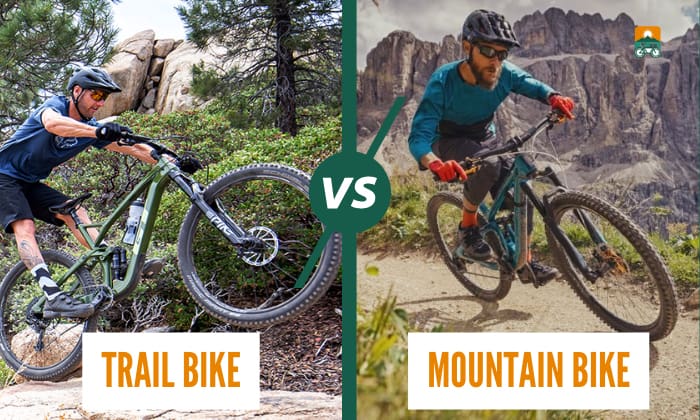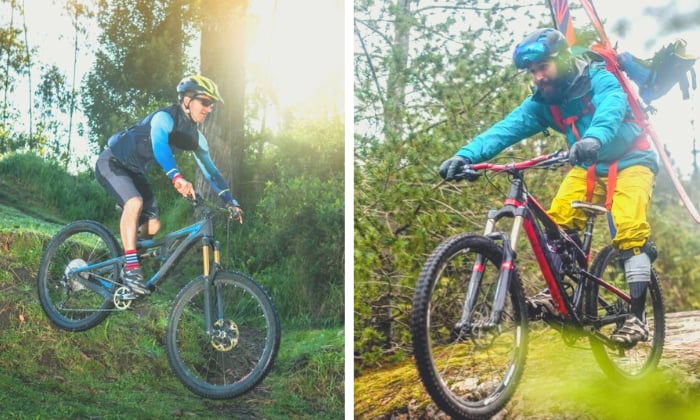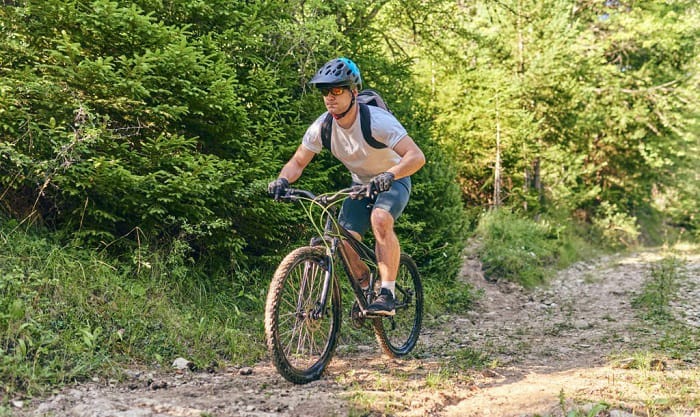When it comes to cycling, the mountain bike is the king of the hill. But if you have concerns about versatility, a trail bike may be worth considering. Let’s look at trail bike vs mountain bike to better understand what you will be getting with each.
We’ll examine these two and see what sets them apart, then compare trail bicycles to standard MTBs and others. You’ll also find a comparison table pitting these two against each other below.
Keep reading to learn more.
| Mountain bike | Trail bike | |
| Utility | Specialized for off-road tracks and terrains | All-rounder models that can take on any terrain, including paved roads |
| Speed | Slow due to its build and weight | Faster than most MTBs but slower than XC and road bikes |
| Build | Tough and durable | Less capable of taking on stress from rough rides |
| Weight | Heavier than other bicycles | Somewhat lighter than standard MTBs |
| Cost | More affordable compared to other cycles | Generally costlier than other MTB models |
Table of Contents
Mountain Bike vs Trail Bike – How they compare
What is a Mountain Bike?
Mountain bikes are specialized for taking on rough terrain. They have larger frames and a higher ground clearance, making them more capable of traversing natural ground.
They are slower compared to road bikes due to their frames, but they are also more durable.
These bicycles can have front and rear suspension systems that make them more comfortable to ride in a variety of conditions, but this depends on which styles of mountain bikes we are looking at. Hardtails do not have suspension systems at the back, for instance.
There are three common subtypes of mountain bikes: the Enduro or all-mountain, the XC (crosscountry), and the downhill.
A key characteristic of mountain bikes is their superior control and traction, allowing them to grip firmly onto very steep hills. They are considerably more challenging to ride, requiring more skill, but developing the necessary technique pays off due to the flexibility this kind of cycle brings.
1. Pros and Cons
- Tough and durable
- Can ride through rough terrains
- More affordable
- Requires skill to use
- Needs frequent maintenance
- Not ideal for paved roads
2. Cost
These are among the more affordable types of bicycles that you’ll find. You can probably find ones at lower prices, but decent models cost around $500 to $1200. Costs increase as the quality of materials improves, and high-end models reach up to $12,000.
If you consider the pros and cons of carbon mountain bikes, the cost would be an important factor as these would be more expensive compared to the more basic steel frame models, although they do offer some excellent perks.
What is a Trail Bike?
Trail bikes are designed to offer everything that MTBs may need. They possess key characteristics of the different styles of mountain bikes but are also capable of taking on paved roads. These general-purpose MTBs can handle almost every situation.
They possess the sturdy build and durable frames that make MTBs versatile, including suspension systems at the front and rear. Their excellent balance allows them to be a mountain bike for road use, effectively solving the MTB’s biggest weakness.
While these bikes started as hobby models aimed at non-competitive use, they have developed to the point that they can now match up with competitive designs for Enduro tracks.
1. Pros and Cons
- More versatile than any other type of MTBs
- Can ride on paved roads
- Great for uneven surfaces
- More expensive than other MTBs and road bikes
- Upkeep is not the easiest.
- Not as suitable for extremely steep hills as other MTBs
2. Cost
Trail bikes are generally more expensive than standard MTBs with price averages of around $1000 to $5000. However, their versatility is an excellent offset to the higher cost, and this fact should be considered well.
Differences between Trail Bikes and MTBs
Mountain bikes for trail riding are much more versatile than regular MTBs that can take on rough terrains. They can do most of everything that MTBs can do.
However, it is also important to note that different mountain bike categories can surpass the trail bike’s capabilities in certain areas.
The differences in what these different bikes can do starts with the characteristics of each type.
- Trail bike bodies are bigger and more rugged compared to those of XCs but lighter than those of Enduros.
- Trail wheels are also bigger and wider than those on XCs, with significant threading to improve grip and stability on different types of surfaces. However, Enduro wheels are still bigger with wider rims, as well as having more air pressure than the softer trail tires.
- MTB frames are sturdy but heavy, which allows them to withstand the beating that comes with taking on the rough natural terrain. However, trail frames are bulkier than XCs but lighter than downhills and Enduros.
- Performance comparisons are also useful to gauge the differences between trail bikes and MTBs. When comparing downhill bike vs trail bike, the latter can take on downhill situations as well but can also ride on obstacle courses and enduro trails.
Trail bikes climb and accelerate better, but downhill designs have the advantage in jumps and cornering.
- When comparing XC bike vs trail hardtail, the trail bike can conquer technical terrains better. However, the comparatively lighter XC bicycle will still fare better when comparing speeds, especially for climbs.
This is why we will also need to look at the trail bike’s shortcomings as a mountain bike used for a particular type of terrain.
These days, there are many existing mountain bike categories with each excelling in a specific type of activity. A mountain bike used for downhill primarily is quite different from one used for climbing.
How much faster is an XC bike vs trail bike? Around 2 to 10% is the answer. On long-distance, less technical terrains, expect the XC bike to be faster.
Making Your Choice
Ultimately, the right choice comes down to your needs for a bicycle. Trail bikes offer such a high degree of versatility that they can be ridden almost anywhere but cannot be expected to perform at the level that more specialized models for racing, downhill rides, etc. can.
If you find yourself needing a bicycle that you can use for daily commutes as well as different kinds of mountain biking, then the trail bike is probably best. However, if you want to perform at the highest level in the most extreme conditions, then you’re probably better off with one of the other types.
Related comparisons: Mountain bike vs Fat bike: Which one should you choose?
Frequently Asked Questions
How can you tell which bicycle is better?
Whichever type of bicycle you’re looking at, it depends on your needs and what you expect to spend your time doing. All mountain vs trail boils down to whether you expect to explore different types of terrain, and the same can be said of other types.
Most type of mountain bikes are specialized in the activity that they can handle, and many people are fine with having different models to handle different activities. However, if you want one kind to take on everything, then the trail bike is probably the better choice.
What tips are there to choose the right bike for yourself?
Consider two points for choosing the right one aside from use—cost and a bicycle’s strengths. The trail mountain bike is an all-rounder. XCCs are light and swift, while Enduros are ideal for descents and downhills have the biggest brakes and most suspension travel.
So, whether you’re picking trail riding bikes or something else, it’s also a good idea to try riding different types of bicycles to get a feel for each and see if you prefer how one feels compared to others.
Can I use a mountain bike on a trail?
Yes, MTBs are well suited for any type of off-road riding, including taking on trails of any kind. Even very rugged trails are not a problem; the only real limit is the condition of the bicycle and the rider’s skill.
Is it OK to use a trail bike on roads?
Yes, it is but these are more difficult to ride on such surfaces compared to road bikes. Among the different MTBs, cross-country bikes are the easiest to ride on roads due to their lighter weight, but trail bicycles are probably next, since they are lighter than others except for XC types.
MTBs have wider tires, resulting in more resistance when on paved roads. So, is mountain bike good for road? You can certainly use one in this scenario, but it’s best to change the tires first.
Conclusion
Now you have a better understanding of trail bike vs mountain bike and what makes each type a good biking asset. All that is left is to properly evaluate your needs, and you should be able to make an informed decision. Take your time deciding to come up with a choice that you can be comfortable with.
What do you think is most important when choosing a bicycle? Is cost the primary consideration or is it something else? Tell us what you think in the comments section below.
Always ride safely.

“I ride my bike to work for years, but is that enough? Our carelessness towards our surroundings has taken a toll on the environment. And now, everyone is responsible for changes; even the most minor contribution is counted. With this hope and spirit, I started with my partner to establish Biketoworkday to help more individuals commute to their work sites on their bikes.”






